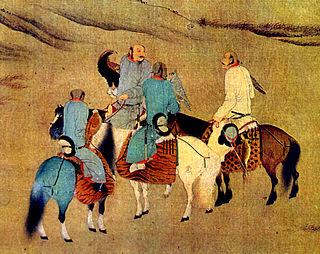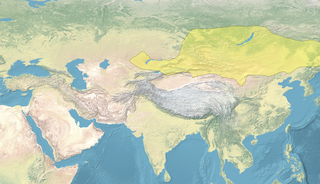Related Research Articles

The Göktürks, Türüks, Celestial Turks or Blue Turks, alternatively Great Turks or Root Turks were a nomadic confederation of Turkic peoples in medieval Inner Asia. The Göktürks, under the leadership of Bumin Qaghan and his sons, succeeded the Rouran Khaganate as the main power in the region and established the First Turkic Khaganate, one of several nomadic dynasties that would shape the future geolocation, culture, and dominant beliefs of Turkic peoples.

The history of the Khitans dates back to the 4th century. The Khitan people dominated much of northern China, Manchuria and the Mongolian Plateau. They subsequently established the Liao dynasty and the Western Liao dynasty.
The proto-Mongols emerged from an area that had been inhabited by humans and predecessor hominin species as far back as 45,000 years ago during the Upper Paleolithic. The people there went through the Bronze and Iron Ages, forming tribal alliances, peopling, and coming into conflict with early polities in the Central Plain.
Heqin, also known as marriage alliance, refers to the historical practice of Chinese monarchs marrying princesses—usually members of minor branches of the ruling family—to rulers of neighboring states. It was often adopted as an appeasement strategy with an enemy state that was too powerful to defeat on the battlefield. The policy was not always effective. It implied an equal diplomatic status between the two monarchs. As a result, it was controversial and had many critics.
Khagan or Qaghan is a title of imperial rank in Turkic, Mongolic, and some other languages, equal to the status of emperor and someone who rules a khaganate (empire). The female equivalent is Khatun.
Tarkhan is an ancient Central Asian title used by various Turkic, Hungarian, Mongolic, and even Iranian peoples. Its use was common among the successors of the Mongol Empire and Turkic Khaganate.

Shiwei were a Mongolic people that inhabited far-eastern Mongolia, northern Inner Mongolia, northern Manchuria and the area near the Okhotsk Sea beach. Records mentioning the Shiwei were recorded from the time of the Northern Wei (386–534) until the rise of the Mongols under Genghis Khan in 1206 when the name "Mongol" and "Tatar" were applied to all the Shiwei tribes.
The Uyghur Khaganate was a Turkic empire that existed for about a century between the mid 8th and 9th centuries. It was a tribal confederation under the Orkhon Uyghur (回鶻) nobility, referred to by the Chinese as the Jiu Xing, a calque of the name Toquz Oghuz or Toquz Tughluq.
A khanate or khaganate is the name for a type of historic polity ruled by a khan, khagan, khatun, or khanum. Khanates were typically nomadic Turkic, Mongol and Tatar societies located on the Eurasian Steppe, politically equivalent in status to kinship-based chiefdoms and feudal monarchies. Khanates and khaganates were organised tribally, where leaders gained power on the support and loyalty of their warrior subjects, gaining tribute from subordinates as realm funding. In comparison to a khanate, a khaganate, the realm of a khagan, was a large nomadic state maintaining subjugation over numerous smaller khanates. The title of khagan, translating as "Khan of the Khans", roughly corresponds in status to that of an emperor.

Nomadic empires, sometimes also called steppe empires, Central or Inner Asian empires, were the empires erected by the bow-wielding, horse-riding, nomadic people in the Eurasian Steppe, from classical antiquity (Scythia) to the early modern era (Dzungars). They are the most prominent example of non-sedentary polities.

The Shatuo, or the Shatuo Turks were a Turkic tribe that heavily influenced northern Chinese politics from the late ninth century through the tenth century. They are noted for founding three, Later Tang, Later Jin, and Later Han, of the five dynasties and one, Northern Han, of the ten kingdoms during the Five Dynasties and Ten Kingdoms period. The Northern Han would later be conquered by the Song dynasty. Sometime before the 12th century, the Shatuo disappeared as a distinct ethnic group, many of them having become acculturated and assimilating into the general population around them.

The Eastern Turkic Khaganate was a Turkic khaganate formed as a result of the internecine wars in the beginning of the 7th century after the First Turkic Khaganate had splintered into two polities – one in the east and the other in the west. Finally, the Eastern Turkic Khaganate was defeated and absorbed by the Tang dynasty, and Xueyantuo occupied the territory of the former Turkic Khaganate.
Qapaghan or Qapghan Qaghan was the second khagan of the Second Turkic Khaganate during Wu Zetian's reign and was the younger brother of the first kaghan, Ilterish Qaghan.

The Kharchin, or Kharachin, is a subgroup of the Mongols residing mainly in North-western Liaoning and Chifeng, Inner Mongolia. There are Khalkha-Kharchin Mongols in Dorno-Gobi Province and in Ulaanbaatar, Mongolia.

The Khitan people were a historical nomadic people from Northeast Asia who, from the 4th century, inhabited an area corresponding to parts of modern Mongolia, Northeast China and the Russian Far East.

The Xianbei state or Xianbei confederation was a nomadic empire which existed in modern-day Mongolia, Inner Mongolia, northern Xinjiang, Northeast China, Gansu, Buryatia, Zabaykalsky Krai, Irkutsk Oblast, Tuva, Altai Republic and eastern Kazakhstan from c. 93 to 234. Like most ancient peoples known through Chinese historiography, the ethnic makeup of the Xianbei is unclear, though they are believed to have been a Proto-Mongolic people. There are also other strong suggestions that they were a multi-ethnic confederation with Mongolic and Turkic influences. They originated from the Donghu people who splintered into the Wuhuan and Xianbei when they were defeated by the Xiongnu at the end of the third century BC. Following the split, the Xianbei people did not have a direct contact with the Han Dynasty, residing to the North of Wuhuan. In the first centruy BC, the Xianbei began to actively engage in the struggle between Han Dynasty and the Xiongnu, which culminated in the Xianbei succeeding even to replace the Xiongnu in 93 AD.
Various nomadic empires, including the Xiongnu, the Xianbei state, the Rouran Khaganate (330–555), the First (552–603) and Second Turkic Khaganates (682–744) and others, ruled the area of present-day Mongolia. The Khitan people, who used a para-Mongolic language, founded an empire known as the Liao dynasty (916–1125), and ruled Mongolia and portions of North China, northern Korea, and the present-day Russian Far East.

This article summarizes the History of the eastern steppe, the eastern third of the Eurasian Steppe, that is, the grasslands of Mongolia and northern China. It is a companion to History of the central steppe and History of the western steppe. Most of its recorded history deals with conflicts between the Han Chinese and the steppe nomads. Most of the sources are Chinese.

The Kyrgyz Khaganate was a Turkic empire that existed for about a century between the early 6th and 13th centuries. It ruled over the Yenisei Kyrgyz people, who had been located in southern Siberia since the 6th century. By the 9th century, the Kyrgyz had asserted dominance over the Uyghurs who had previously ruled the Kyrgyz. The empire was established as a khaganate from 539 to 1218, lasting 679 years. The khaganate's territory at its height would briefly include parts of modern-day China, Kazakhstan, Kyrgyzstan, Mongolia, and Russia. After the 10th century, there was little information on the Yenisei Kyrgyz. It is believed the khaganate had survived in its traditional homeland until 1207.
Khan of Heaven or Tian Kehan, Celestial Kha(ga)n, Heavenly Kha(ga)n, Tengri Kha(ga)n was a title addressed to the Emperor Taizong of Tang by various Turkic nomads. It was first mentioned in accounts on May 20, 630 and again on October 24, 646, shortly after the Eastern Turkic Khaganate and Xueyantuo were annihilated by the Tang dynasty.
References
- ↑ "Xiongnu-- En el invierno del 200 adC". Dimelo. Archived from the original on 2007-09-27. Retrieved 2007-08-31.
- ↑ "Dallas MsCurley-Juedixi, Entertainment of War in Early China". Project Muse. Retrieved 2007-08-31.
- ↑ Dr., Prof. Ts. Gantulga, Dr. T. Jambaldorj, Dr., Prof. S. Tsolmon, Dr., Prof. J. Zaanhuu, T. Altanceceg, S. Sodnam (2005). History of Mongolia II. Ulaanbaatar.
{{cite book}}: CS1 maint: location missing publisher (link) CS1 maint: multiple names: authors list (link) - ↑ D. Sinor; S. G. Klyashtorny (1996). "The Türk Empire". History of civilizations of Central Asia. Vol. 3. UNESCO. p. 339.
- ↑ "Chronological table of history of Siberia and Mongolia". Historical Server of Central Asia. Archived from the original on 2007-08-07. Retrieved 2007-10-09.
- ↑ F.W. Mote (1999). Imperial China, 900-1800. Harvard University Press. pp. 68–71, 123–124. ISBN 0-674-01212-7.
- ↑ Tao, Jing-shen (1988). Two Sons of Heaven: Studies in Sung-Liao Relations. University of Arizona Press. ISBN 0-8165-1051-2.
- ↑ Goodrich, Luther Carrington (2007-03-01). A Short History of the Chinese People. Read Books. ISBN 978-1-4067-6976-0.
- ↑ Laird, Thomas (2006). The Story of Tibet: Conversations with the Dalai Lama, p. 141. Grove Press, N.Y. ISBN 978-0-8021-1827-1.
- ↑ Luvsandanzan (1600s). Алтан товч (Altan Tobchi). Mongolia.
- ↑ Dai Qing Tai-Ju Gao-Hoangdi Shi-lu. (History of the Great Qing Tai-Ju Emperor). Tokio.